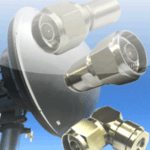WiMAX (Worldwide Interoperability for Microwave Access) is a wireless communications standard designed to provide 30 to 40 megabit-per-second data rates, with the 2011 update providing up to 1 Gbit/s for fixed stations. The name “WiMAX” was created by the WiMAX Forum, which was formed in June 2001 to promote conformity and interoperability of the standard. The forum describes WiMAX as “a standards-based technology enabling the delivery of last mile wireless broadband access as an alternative to cable and DSL”.
Terminology
WiMAX refers to interoperable implementations of the IEEE 802.16 family of wireless-networks standards ratified by the WiMAX Forum. (Similarly, WiFi refers to interoperable implementations of the IEEE 802.11 Wireless LAN standards certified by the Wi-Fi Alliance.) WiMAX Forum certification allows vendors to sell fixed or mobile products as WiMAX certified, thus ensuring a level of interoperability with other certified products, as long as they fit the same profile.
The original IEEE 802.16 standard (now called “Fixed WiMAX”) was published in 2001. WiMAX adopted some of its technology from WiBro, a service marketed in Korea.
Mobile WiMAX (originally based on 802.16e-2005) is the revision that was deployed in many countries, and is the basis for future revisions such as 802.16m-2011.
WiMAX is sometimes referred to as “Wi-Fi on steroids” and can be used for a number of applications including broadband connections, cellular backhaul, hotspots, etc. It is similar to Wi-Fi, but it can enable usage at much greater distances



